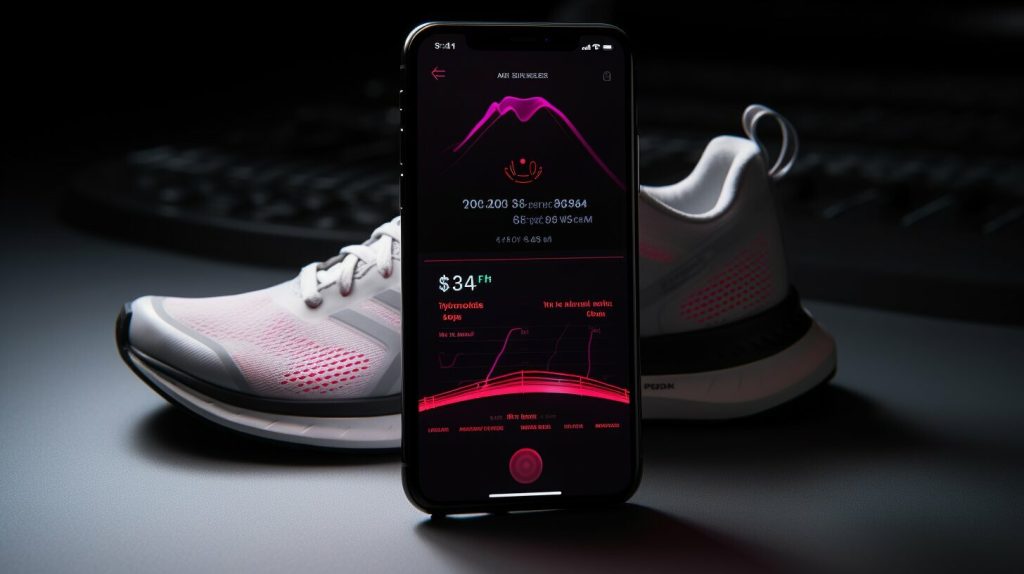Interval running for weight loss is highly effective, and in this article, I will guide you through practical tips and proven plans to jumpstart your weight loss journey.
Key Takeaways:
- Interval running involves alternating periods of intense activity with moments of rest.
- It is more effective at burning fat and calories compared to steady-state cardio.
- High-intensity intervals create an afterburn effect, leading to continued calorie burn after the workout.
- Interval training can be tailored to individual fitness levels and incorporated into running workouts for beginners and experienced runners.
- Running at high intensity, such as sprints or at 85-90% of maximum effort, followed by recovery periods, is recommended for optimal results.
What is Interval Running for Weight Loss?
Interval running, also known as high-intensity interval training (HIIT) for weight loss, is a workout technique that involves alternating intense activity with periods of rest. This type of training has gained popularity for its effectiveness in burning fat and calories.
Unlike traditional steady-state cardio, interval running pushes your body to its limits, resulting in a greater calorie burn both during and after the workout. The high-intensity intervals create an afterburn effect, where the body continues to burn calories even when at rest.
Interval training can be tailored to individual fitness levels, making it suitable for both beginners and experienced runners. For beginners, incorporating short bursts of higher intensity intervals into their regular running workouts can provide a challenge without overwhelming the body.
More experienced runners can engage in longer, more intense intervals to further enhance their endurance and weight loss efforts.
Running at a high intensity for short durations, such as sprints or at 85-90% of maximum effort, followed by active recovery or rest periods, is the key to interval training.
The combination of pushing your body to its limits and allowing it to recover repeatedly during the workout helps to optimize fat burn and improve cardiovascular fitness. This method also saves time as shorter, more intense workouts can be just as effective, if not more, than longer, steady-state cardio sessions.
To maximize the benefits of interval running, it is important to warm up properly before starting the workout. A proper warm-up helps to prepare your body for the intense exercise, reduce the risk of injury, and enhance performance.
Additionally, cooling down and incorporating rest days into your training schedule are essential for recovery and to prevent overtraining. Giving your body time to rest and repair allows for better adaptation and improved results.

| Steady-State Cardio | Interval Running | |
|---|---|---|
| Calories Burned | High | Higher |
| Time Efficiency | Longer duration required | Shorter duration |
| Cardiovascular Fitness | Improved | Improved |
| Fat Burning | Effective | Highly effective |
“Interval running is a game-changer when it comes to weight loss. The intense intervals push your body to burn more calories and fat, resulting in faster and more significant results. Plus, the versatility and flexibility of interval training make it accessible to everyone, regardless of fitness level.
Start incorporating intervals into your running workouts and experience the power of high-intensity interval training for weight loss!” – Fitness Expert
The Benefits of Interval Running
Interval running offers numerous benefits, including increased fat burn, improved cardiovascular fitness, and time efficiency. By incorporating high-intensity intervals into your running workouts, you can maximize calorie expenditure and accelerate weight loss.
The intense bursts of activity during interval training stimulate the body to burn calories at a higher rate even after the workout, thanks to the “afterburn effect.”
Research has shown that interval training is more effective for fat loss compared to steady-state cardio exercises. The alternating periods of intense effort followed by short recovery periods challenge your body and push it to adapt.
This high-intensity approach not only burns more calories during the workout but also enhances your metabolism, enabling you to continue burning calories long after you’ve finished exercising.
One of the advantages of interval running is its versatility. It can be tailored to suit different fitness levels, making it accessible to beginners and experienced runners alike. Whether you’re just starting your fitness journey or looking to take your running performance to the next level, interval running can be customized to meet your specific goals.

Furthermore, interval running can be done either on a treadmill or outdoors, giving you the flexibility to choose your preferred setting. If you prefer the controlled environment of a gym, a treadmill offers the convenience of adjusting speed and incline to create challenging intervals.
On the other hand, running outdoors provides the opportunity to enjoy fresh air and varied terrain, which can further enhance the workout experience.
To make the most out of your interval running sessions, it’s important to warm up properly before diving into the intense intervals. A dynamic warm-up routine can help prepare your muscles for the exertion and reduce the risk of injury. Additionally, incorporating cooldown periods and scheduling rest days for recovery is essential for allowing your body to adapt and optimize the benefits of interval training.
| Benefits of Interval Running | |
|---|---|
| Increased fat burn | |
| Improved cardiovascular fitness | |
| Time efficiency | |
| How to Incorporate Interval Training into Running Workouts | |
| Tailor intervals to individual fitness levels | |
| Warm up properly before workouts | |
| Include cooldown periods for recovery | |
| Interval Running on the Treadmill or Outdoors | |
| Choose based on personal preference and accessibility | |
| Treadmill offers controlled environment and adjustable settings | |
| Running outdoors provides fresh air and varied terrain | |
How to Incorporate Interval Training into Running Workouts
If you want to maximize weight loss through running, incorporating interval training into your workouts is key. Here’s how you can do it, regardless of your fitness level.
To start, determine your current fitness level and choose an interval training plan that suits you. Beginners can begin with shorter intervals of high-intensity running followed by longer periods of recovery. For example, run at a fast pace for 30 seconds, then walk or jog for 1-2 minutes to recover. As you progress, gradually increase the intensity and duration of the high-intensity intervals.
Experienced runners can try more advanced interval training methods, such as pyramid intervals. Start with a moderate pace for 1 minute, then increase the intensity for the next minute. Continue to increase the intensity for each subsequent minute until reaching the peak, then decrease back to a moderate pace. Repeat this pyramid pattern for a challenging and effective workout.
You can also incorporate interval training into your regular running routine by adding short bursts of speed. For example, during your usual run, pick a landmark ahead and sprint to it. Once you reach the landmark, slow down to a recovery pace until you feel ready to sprint again. Repeat this pattern several times throughout your run to reap the benefits of interval training.
Sample Interval Training Workout
Warm-up: Start with a brisk walk or slow jog for 5-10 minutes to prepare your body for the workout.
| Interval | Duration | Intensity | Recovery |
|---|---|---|---|
| 1 | 30 seconds | Sprint | 1 minute |
| 2 | 1 minute | Jog | 2 minutes |
| 3 | 45 seconds | Sprint | 1 minute |
| 4 | 1 minute | Jog | 2 minutes |
| 5 | 1 minute | Sprint | 1 minute |
| 6 | 1 minute | Jog | 2 minutes |
Cool-down: Finish your workout with a 5-10 minute slow jog or walk to gradually lower your heart rate and help your body recover.
Remember to listen to your body and adjust the intensity and duration of intervals as needed. Interval training can be challenging, but it is an effective way to boost your weight loss efforts and improve your overall fitness. Stay consistent, stay motivated, and enjoy the benefits of interval running workouts.
The Optimal Intensity and Duration for Interval Running
To achieve the best results in terms of weight loss, interval running should be performed at an optimal intensity and duration. High-intensity intervals, such as sprints or running at 85-90% of maximum effort, are recommended. These intense bursts of activity create an afterburn effect, where the body continues to burn calories even after the workout is complete. It’s important to push yourself during these intervals, challenging your limits to maximize calorie burn and fat loss.
When it comes to the duration of intervals, shorter bursts followed by recovery periods are the most effective. For example, you might sprint for 30 seconds and then rest or jog for 60 seconds before starting another sprint. This pattern can be repeated for a set number of intervals or for a specific time duration, depending on your fitness level and goals.
While it’s important to push yourself during the high-intensity intervals, it’s equally important to listen to your body and take breaks when needed. Overtraining can lead to injuries and hinder your progress. Proper warm-up and cooldown periods are also crucial for injury prevention and optimal performance. A well-rounded interval running workout should include a dynamic warm-up to increase blood flow to the muscles and prepare them for the intensity of the workout. After the workout, a cooldown period allows your heart rate to gradually return to its resting state and helps prevent muscle soreness.
| Key Points | Optimal Intensity and Duration |
|---|---|
| Intensity | High-intensity intervals, such as sprints or running at 85-90% of maximum effort |
| Duration | Short bursts followed by recovery periods. For example, sprint for 30 seconds, rest or jog for 60 seconds, and repeat |
| Warm-up and Cooldown | Properly warm up before the workout and include a cooldown period to prevent injuries and muscle soreness |
By incorporating interval running into your workouts at the optimal intensity and duration, you can maximize your weight loss efforts. This type of training not only burns more calories during the workout but also increases your metabolic rate, leading to continued calorie burn throughout the day. Remember to tailor the intensity and duration of your intervals to your fitness level and gradually increase the intensity as you become fitter. With consistency and dedication, interval running can become a powerful tool in your weight loss journey.

A proper warm-up and cooldown routine are essential for a successful interval running session. Warm-up exercises help prepare the body for the intense activity to come, while a proper cooldown allows for gradual recovery and reduces the risk of injury.
Before starting your interval running workout, begin with a dynamic warm-up. This can include exercises such as leg swings, high knees, arm circles, and lunges. Performing these movements will increase blood flow, loosen up the muscles, and activate the joints, preparing your body for the upcoming high-intensity intervals.
After completing your interval running session, it’s important to cool down properly. Gradually decrease your pace and allow your body to recover. This can be done by walking or jogging at a slower pace. Follow it up with static stretches to improve flexibility and help prevent muscle soreness. Focus on stretching the major muscle groups such as your calves, hamstrings, quadriceps, and hip flexors.

Remember, a proper warm-up and cooldown routine are just as important as the actual interval running workout itself. They ensure that your body is adequately prepared for the intense activity and help reduce the risk of injuries. Include these warm-up and cooldown exercises in your interval running routine to optimize your performance and enhance your weight loss goals.
Interval Running on the Treadmill or Outdoors
Interval running can be done either on a treadmill or outdoors, depending on your preferences and availability. Both options have their benefits, so choose what works best for you. If you prefer the controlled environment and convenience of a treadmill, you can easily adjust the speed and incline to create the desired intensity for your intervals. Treadmills also offer the advantage of a cushioned surface, reducing the impact on your joints.
On the other hand, running outdoors allows you to enjoy fresh air and varied terrain, which can make your workouts more engaging. You can incorporate hills, stairs, or other natural features into your interval training, adding an extra challenge to your routine. Just make sure to choose a safe and well-lit route if you prefer to run outdoors, especially during low-light hours.
Remember to warm up properly before starting your interval running workout, regardless of whether you choose the treadmill or outdoors. This will help prepare your muscles and prevent injuries. Cooling down after the workout is equally important for recovery and reducing post-exercise soreness. Take the time to stretch your muscles and allow your heart rate to gradually return to normal.

| Benefits of Interval Running |
|---|
| Increased fat burn |
| Improved cardiovascular fitness |
| Time efficiency |
Testimonial: The Power of Interval Training
“Interval running has been a game-changer for my weight loss journey. I used to spend hours on the treadmill, but once I started incorporating intervals, I saw a significant difference in my body composition. Not only did I shed excess weight, but my endurance and overall fitness level also improved. It’s challenging, but the results are worth it!” – Sarah D.
Mobile Apps for Interval Running
Several mobile apps are available to track and guide your interval running workouts, allowing for easy monitoring and effective training. These apps provide a range of features to help you stay on track with your fitness goals. From interval timers and distance tracking to personalized training plans and audio cues, these apps offer a convenient and interactive way to enhance your interval running workouts.
One popular app is “Interval Run”, which offers customizable interval timers and audio cues to guide you through your workout. You can set the duration of your high-intensity intervals and recovery periods, and the app will notify you when it’s time to switch. It also tracks your distance, pace, and calories burned, providing valuable data for monitoring your progress.
Another highly rated app is “Runkeeper”, which not only tracks your interval running workouts but also provides personalized training plans. You can choose from a variety of interval workouts designed specifically for weight loss and performance improvement. The app also offers audio coaching that provides real-time feedback and motivation during your runs.
| App Name | Features |
|---|---|
| Interval Run | – Customizable interval timers – Audio cues – Distance tracking |
| Runkeeper | – Personalized training plans – Interval workouts for weight loss – Real-time audio coaching |
For those who prefer a social aspect to their workouts, the “Nike+ Run Club” app allows you to connect with friends and participate in virtual challenges. The app also includes interval training options and provides detailed post-workout summaries to help you analyze your performance.
Whether you’re a beginner or an experienced runner, utilizing mobile apps for interval running can help you stay motivated, track your progress, and achieve your weight loss goals. With the convenience of these apps at your fingertips, you can take your interval training to the next level and see significant results.

Hill Repeats as an Effective Interval Training Method
Hill repeats are a powerful and effective method of interval training that can supercharge your weight loss progress. This type of training involves running up a hill at a high intensity for a short duration, followed by a recovery period. The incline of the hill adds an extra challenge to your workout, increasing the intensity and helping you burn more calories.
By incorporating hill repeats into your running routine, you can target different muscle groups and improve your overall strength and endurance. The uphill sprints engage your glutes, hamstrings, and calves, while the downhill recovery allows for active rest and helps your body recover faster.
To perform hill repeats, find a hill with a moderate incline and a length of about 200 to 400 meters. Start by warming up with a light jog or dynamic stretches to prepare your muscles for the intense effort. Then, sprint up the hill at maximum effort for 30 to 60 seconds, focusing on maintaining good form and driving your knees forward. Once you reach the top, recover by jogging or walking back down the hill. Repeat this process for a total of 5 to 10 hill repeats, depending on your fitness level and goals.
Incorporating hill repeats into your interval training routine can help you break through weight loss plateaus and take your running to the next level. Remember to listen to your body and adjust the intensity and duration as needed. Stay consistent and gradually increase the number of hill repeats over time to continue challenging yourself and achieving your weight loss goals.

| Benefits of Hill Repeats: |
|---|
| Increases calorie burn |
| Builds strength and endurance |
| Targets different muscle groups |
| Provides a cardiovascular challenge |
| Enhances running form |
| Breaks through weight loss plateaus |
Creating a Negative Energy Balance for Weight Loss
Achieving weight loss through running requires creating a negative energy balance by burning more calories than you consume, along with making healthy lifestyle and dietary adjustments. Interval running, with its high-intensity intervals and calorie-burning benefits, can be an effective strategy to help you reach your weight loss goals.
Interval training involves alternating periods of intense activity with moments of rest. These bursts of high-intensity exercise increase your heart rate and stimulate your metabolism, leading to greater calorie burn during and after your workout. Research has shown that interval training is more effective in burning fat and calories compared to traditional steady-state cardio exercises.
To incorporate interval training into your running workouts, you can start by adding short bursts of high-intensity running, such as sprints or running at 85-90% of your maximum effort, followed by recovery periods of lower intensity or rest. This alternating pattern challenges your body, improves cardiovascular fitness, and helps you burn more calories in a shorter amount of time.
It’s important to warm up properly before engaging in interval running to prevent injury and maximize performance. A dynamic warm-up routine that includes dynamic stretching and mobility exercises can prepare your muscles and joints for the intense workout ahead. Additionally, don’t forget to include cooldown periods after your interval running sessions to allow your body to recover and reduce the risk of muscle soreness.
Remember, interval running can be done on a treadmill or outdoors, depending on your preference and accessibility. There are also various mobile apps available that can track and guide your interval running workouts, providing structure and motivation along the way.
For a comprehensive approach to weight loss through running, it’s important to create a negative energy balance by burning more calories than you consume. This can be achieved not only through interval running but also by incorporating other healthy lifestyle changes, such as maintaining a balanced diet, staying hydrated, and getting enough sleep. Consulting with a healthcare professional or a certified trainer can help you develop a personalized plan that suits your fitness level and weight loss goals.

Rest and recovery are vital components of interval running to prevent overtraining and optimize your weight loss journey. While high-intensity intervals are effective at burning calories and fat, it’s important to give your body time to rest and repair. Without adequate rest, you risk injury, decreased performance, and increased fatigue.
One way to ensure proper rest and recovery is to incorporate cooldown periods into your interval running workouts. After completing your high-intensity intervals, gradually decrease your intensity and allow your heart rate to return to normal. This cooldown period helps your body transition from the intense exercise to a resting state, reducing the risk of muscle soreness and injury.
Additionally, rest days are essential for allowing your body to recover and adapt to the stress of interval training. On these rest days, engage in low-impact activities like walking or stretching to promote blood flow and aid in muscle recovery. It’s important to listen to your body and take rest days when needed to prevent overtraining and maintain overall health.

| Benefits of Rest and Recovery in Interval Running |
|---|
| Reduces the risk of overuse injuries |
| Promotes muscle repair and growth |
| Prevents burnout and mental fatigue |
| Improves overall performance and endurance |
Remember, interval running is a challenging form of exercise that puts stress on your body. By prioritizing rest and recovery, you allow your body to adapt and become stronger over time. Don’t underestimate the importance of rest in achieving your weight loss goals through interval running.
Sample Interval Running Schedule with Rest and Recovery
- Monday: Interval running workout
- Tuesday: Active recovery day (light walking or stretching)
- Wednesday: Rest day
- Thursday: Interval running workout
- Friday: Rest day
- Saturday: Long steady-state run
- Sunday: Rest day
By incorporating rest and recovery into your interval running routine, you can optimize your weight loss journey and improve your overall fitness. Don’t underestimate the power of rest — it’s an essential part of the equation for success.
Conclusion
Interval running is a powerful method for weight loss, and by incorporating it into your fitness routine and following a well-structured interval running program, you can achieve significant results. This type of training, which alternates between periods of intense activity and rest, has been proven to be highly effective at burning fat and calories. Unlike steady-state cardio, interval training creates an afterburn effect, where your body continues to burn calories even after your workout is over.
One of the great things about interval running is that it can be tailored to your individual fitness level. Whether you’re a beginner or an experienced runner, you can adjust the intensity and duration of your intervals to suit your needs. For the best weight loss results, aim for high-intensity intervals such as sprints or running at 85-90% of your maximum effort for short durations, followed by recovery periods.
When it comes to weight loss through running, it’s important to create a negative energy balance by burning more calories than you consume. Interval running can help you achieve this by burning calories both during and after your workout.
Don’t miss out! Stay tuned for riveting articles at the crossroads of health and technology. Your path to a brighter, healthier future starts here.
FAQ
Q: What is interval running?
A: Interval running involves alternating periods of intense activity with moments of rest. It is a highly effective method for weight loss through running.
Q: What are the benefits of interval running?
A: Interval running has several benefits, including increased fat burn, improved cardiovascular fitness, and time efficiency.
Q: How can I incorporate interval training into my running workouts?
A: Interval training can be tailored to individual fitness levels and can be incorporated into running workouts for beginners as well as more experienced runners.
Q: What is the optimal intensity and duration for interval running?
A: It is recommended to run at a high intensity, such as sprints or at 85-90% of maximum effort, for short durations followed by recovery periods.
Q: How should I warm up and cool down for interval running?
A: It is important to warm up properly before the workout and include cooldown periods for recovery.
Q: Can interval training be done on a treadmill or outdoors?
A: Yes, interval training can be done on a treadmill or outdoors. Both options have their benefits, and you can choose based on personal preference and accessibility.
Q: Are there any mobile apps available for tracking and guiding interval running workouts?
A: Yes, there are various mobile apps available that can track and guide interval running workouts, providing convenience and structure.
Q: What are hill repeats, and how can they be incorporated into a running routine?
A: Hill repeats are an effective form of interval training that involves running uphill at a high intensity followed by recovery periods. They can be incorporated into a running routine to enhance weight loss efforts.
Q: How can I create a negative energy balance for weight loss through running?
A: To achieve weight loss through running, it is crucial to create a negative energy balance by burning more calories than consumed and incorporating other healthy lifestyle and dietary changes.
Q: How important is rest and recovery in interval running?
A: Rest and recovery are essential in interval running to prevent overtraining and promote optimal results. It is important to include cooldown periods and rest days in your training program.



